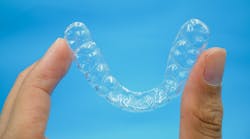Developed in 1997 and cleared by the US Food and Drug Administration in 1998, clear aligners have become increasingly popular. The original patent expired in 2017, allowing companies to create their own custom-made mouthpieces to cater to the needs of patients looking to correct misaligned or crooked teeth.1,2 It is estimated that the global clear aligner market was $4.7 billion in 2021 and will expand at a compound annual growth rate of 29.5% from 2022 to 2030.3
With so many at-home and in-office aligner products on the market, people wanting to transform their smiles now have more options than ever before. In light of increasing demand, it is my opinion that companies should utilize the latest aligner technology in a way that leaves users looking and feeling good throughout the course of their treatment, which becomes the key to differentiating themselves from competitors and boosting patient compliance.
One reason clear aligners are in high demand is because they are removable, helping patients to facilitate better oral health during treatment and minimizing disruption to their lives.4 Brackets and wires make it hard to brush and floss teeth effectively, potentially leading to a buildup of bacteria and, in some cases, periodontitis.4 Because aligners are removable, patients can brush and floss without any obstacles, which helps ensure that they clean bacteria-prone areas. The removable nature of aligners is also enticing to patients because no foods are off-limits, and they don’t fear brackets coming off teeth and wires popping out of place. Although clear aligners are removable, patients must still wear them for the duration of their recommended treatment plan.
Related reading:
- Digital workflow for clear aligner therapy
- The rising demand for clear aligner therapy: How to be efficient, predictable, and profitable
Since the effectiveness of aligners depends on patient compliance in wearing them, comfort is key. Some aligners shift teeth in the first 24 to 48 hours of wear and keep them in place for the duration of treatment, potentially leading to a painful and uncomfortable first few days.5 It’s been my experience that patients who can’t handle the pain associated with rapid teeth movement are tempted to take out the aligner. Some aligners can help provide a more comfortable experience by applying gentle, consistent pressure to move teeth over a longer period of seven days.
The discreet nature in which clear aligners shift teeth into place is another reason their popularity has soared. Unlike metal braces, aligners are made with transparent plastic that makes them barely noticeable. However, saliva, plaque, and bacteria naturally stain aligners, and the discoloration can make teeth appear yellow. To further encourage patient compliance, companies should design clear aligners that are highly stain resistant.
Clear aligners aren’t going away anytime soon. Companies must utilize the latest aligner technology and keep the patient in mind as comfort and compliance will continue to be the key differentiating factors. Products designed to mitigate these issues can help increase user happiness and lead to better results.
Editor's note: This article appeared in the September 2022 print edition of Dental Economics magazine. Dentists in North America are eligible for a complimentary print subscription. Sign up here.
References
- Phulari BS. History of Invisalign. In: Phulari BS, ed. History of Orthodontics: A Glance at an Exciting Path, the Oldest Specialty of Dentistry Has Treaded So Far. Jaypee Brothers Medical Publishers; 2013:226.
- Tindera M. Out of Silicon Valley, a billion-dollar orthodontics business built with plastic and patents. Forbes. April 25, 2017. Accessed March 23, 2022. https://www.forbes.com/sites/michelatindera/2017/04/25/out-of-silicon-valley-a-billion-dollar-orthodontics-business-built-with-plastic-and-patents/
- Clear aligners market size, share & trends analysis report by age (adults, teens), by end-use (hospitals, standalone practices, group practices), by region, and segment forecasts, 2022-2030. Grand View Research. January 2022. Accessed March 23, 2022. https://www.grandviewresearch.com/industry-analysis/clear-aligners-market
- Tamer I, Öztaş E, Marşan G. Orthodontic treatment with clear aligners and the scientific reality behind their marketing: a literature review. Turk J Orthod. 2019;32(4):241-246. doi:10.5152/TurkJOrthod.2019.18083
- Zendura XL. Design verification report: force available to move teeth after stress relaxation tests. Data on file. OraPharma. Accessed May 9, 2022.







